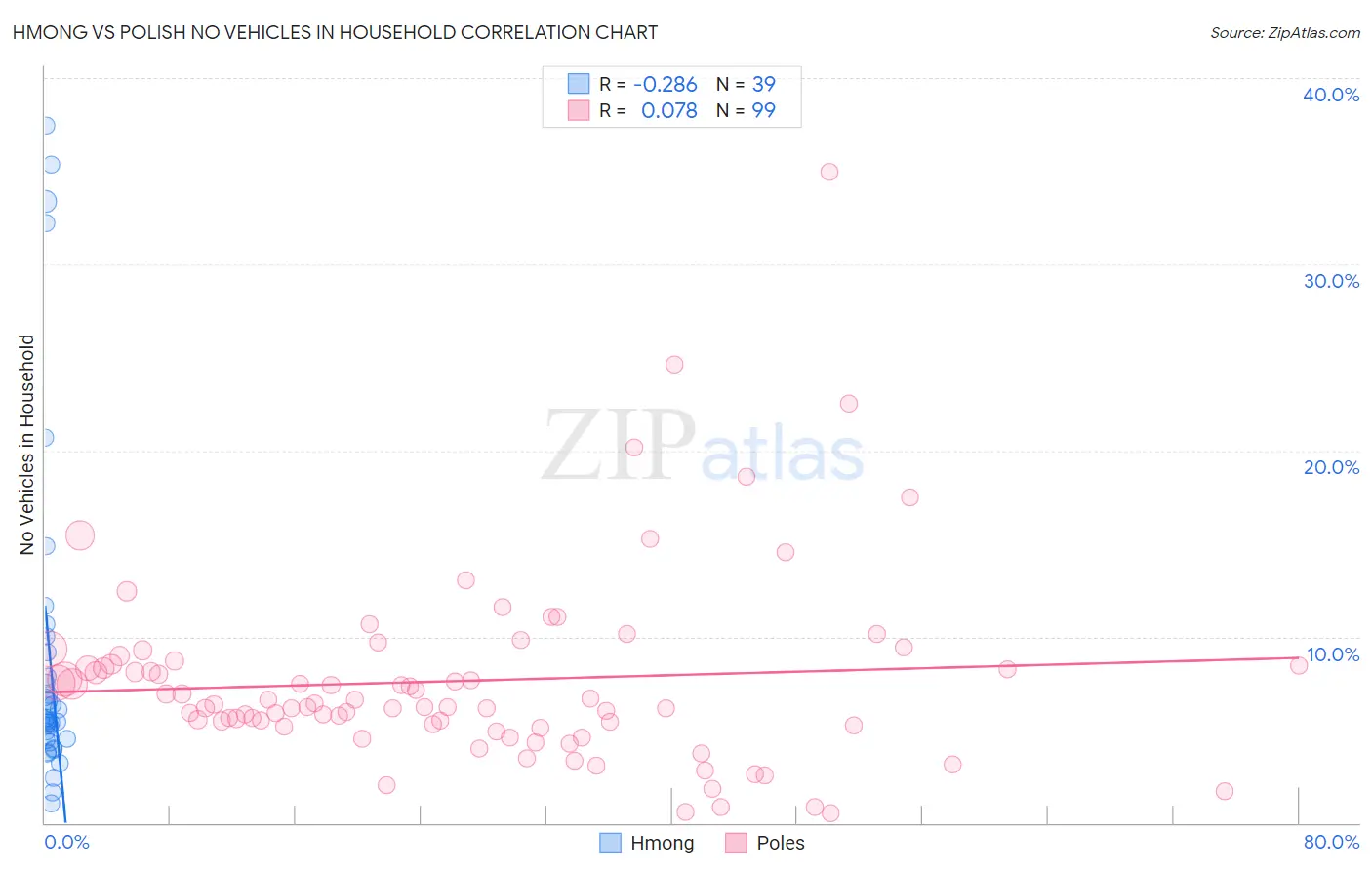Hmong vs Polish No Vehicles in Household
COMPARE
Hmong
Polish
No Vehicles in Household
No Vehicles in Household Comparison
Hmong
Poles
10.4%
NO VEHICLES IN HOUSEHOLD
52.7/ 100
METRIC RATING
171st/ 347
METRIC RANK
8.4%
NO VEHICLES IN HOUSEHOLD
99.6/ 100
METRIC RATING
73rd/ 347
METRIC RANK
Hmong vs Polish No Vehicles in Household Correlation Chart
The statistical analysis conducted on geographies consisting of 24,678,157 people shows a weak negative correlation between the proportion of Hmong and percentage of households with no vehicle available in the United States with a correlation coefficient (R) of -0.286 and weighted average of 10.4%. Similarly, the statistical analysis conducted on geographies consisting of 555,400,436 people shows a slight positive correlation between the proportion of Poles and percentage of households with no vehicle available in the United States with a correlation coefficient (R) of 0.078 and weighted average of 8.4%, a difference of 22.9%.

No Vehicles in Household Correlation Summary
| Measurement | Hmong | Polish |
| Minimum | 1.0% | 0.52% |
| Maximum | 37.4% | 35.0% |
| Range | 36.4% | 34.5% |
| Mean | 9.2% | 7.6% |
| Median | 5.5% | 6.4% |
| Interquartile 25% (IQ1) | 4.5% | 5.3% |
| Interquartile 75% (IQ3) | 9.2% | 8.5% |
| Interquartile Range (IQR) | 4.7% | 3.3% |
| Standard Deviation (Sample) | 9.4% | 5.1% |
| Standard Deviation (Population) | 9.3% | 5.1% |
Similar Demographics by No Vehicles in Household
Demographics Similar to Hmong by No Vehicles in Household
In terms of no vehicles in household, the demographic groups most similar to Hmong are Immigrants from Latin America (10.4%, a difference of 0.060%), Brazilian (10.4%, a difference of 0.14%), Lumbee (10.3%, a difference of 0.28%), Filipino (10.4%, a difference of 0.36%), and Immigrants from Sudan (10.4%, a difference of 0.37%).
| Demographics | Rating | Rank | No Vehicles in Household |
| South Africans | 61.1 /100 | #164 | Good 10.2% |
| Comanche | 60.8 /100 | #165 | Good 10.2% |
| Immigrants | Costa Rica | 60.5 /100 | #166 | Good 10.3% |
| Immigrants | Saudi Arabia | 58.8 /100 | #167 | Average 10.3% |
| Indonesians | 56.7 /100 | #168 | Average 10.3% |
| Lumbee | 54.7 /100 | #169 | Average 10.3% |
| Immigrants | Latin America | 53.2 /100 | #170 | Average 10.4% |
| Hmong | 52.7 /100 | #171 | Average 10.4% |
| Brazilians | 51.7 /100 | #172 | Average 10.4% |
| Filipinos | 50.1 /100 | #173 | Average 10.4% |
| Immigrants | Sudan | 50.0 /100 | #174 | Average 10.4% |
| Immigrants | Burma/Myanmar | 49.1 /100 | #175 | Average 10.4% |
| French American Indians | 49.1 /100 | #176 | Average 10.4% |
| Immigrants | El Salvador | 49.1 /100 | #177 | Average 10.4% |
| Immigrants | Ethiopia | 48.0 /100 | #178 | Average 10.4% |
Demographics Similar to Poles by No Vehicles in Household
In terms of no vehicles in household, the demographic groups most similar to Poles are Lithuanian (8.4%, a difference of 0.030%), Immigrants from Lebanon (8.4%, a difference of 0.060%), Cajun (8.4%, a difference of 0.090%), Spaniard (8.4%, a difference of 0.81%), and Cuban (8.5%, a difference of 0.86%).
| Demographics | Rating | Rank | No Vehicles in Household |
| Palestinians | 99.7 /100 | #66 | Exceptional 8.3% |
| Immigrants | Scotland | 99.7 /100 | #67 | Exceptional 8.3% |
| Immigrants | Iran | 99.7 /100 | #68 | Exceptional 8.4% |
| Spaniards | 99.7 /100 | #69 | Exceptional 8.4% |
| Cajuns | 99.6 /100 | #70 | Exceptional 8.4% |
| Immigrants | Lebanon | 99.6 /100 | #71 | Exceptional 8.4% |
| Lithuanians | 99.6 /100 | #72 | Exceptional 8.4% |
| Poles | 99.6 /100 | #73 | Exceptional 8.4% |
| Cubans | 99.5 /100 | #74 | Exceptional 8.5% |
| Jordanians | 99.5 /100 | #75 | Exceptional 8.5% |
| Immigrants | Philippines | 99.5 /100 | #76 | Exceptional 8.5% |
| Iranians | 99.5 /100 | #77 | Exceptional 8.6% |
| Immigrants | South Central Asia | 99.5 /100 | #78 | Exceptional 8.6% |
| Portuguese | 99.5 /100 | #79 | Exceptional 8.6% |
| Bolivians | 99.4 /100 | #80 | Exceptional 8.6% |